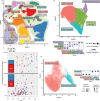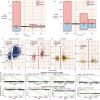Integrated single-cell multiomic profiling of caudate nucleus suggests key mechanisms in alcohol use disorder
- PMID: 41083468
- PMCID: PMC12518533
- DOI: 10.1038/s41467-025-64136-0
Integrated single-cell multiomic profiling of caudate nucleus suggests key mechanisms in alcohol use disorder
Abstract
Alcohol use disorder (AUD) induces complex transcriptional and regulatory changes across multiple brain regions including the caudate nucleus, which remains understudied. Using paired single-nucleus RNA-seq and ATAC-seq on caudate samples from 143 human postmortem brains, including 74 with AUD, we identified 17 distinct cell types. A significant portion of the alcohol-related differences in gene expression were accompanied by a corresponding difference in chromatin accessibility within the gene. We observed transcriptional differences in medium spiny neurons that impact RNA metabolism and immune response pathways. A small cluster of D1/D2 hybrid neurons showed AUD-induced differences distinct from the D1 and D2 types, suggesting a unique role in AUD. Those with AUD had a higher proportion of microglia in an inflammatory state; astrocytes entered a reactive state partially regulated by JUND. Oligodendrocyte dysregulation was driven in part by OLIG2 activity and increased TGF-β1 signaling from microglia and astrocytes. We also observed increased microglia-astrocyte communication via the IL-1β pathway. These findings provide valuable insights into the genetic and cellular mechanisms in the caudate related to AUD. They also demonstrate the broader utility of large-scale multiomic studies in uncovering complex gene regulation across diverse cell types, which has implications beyond the substance use field.
© 2025. The Author(s).
Conflict of interest statement
Competing interests: The authors declare no competing interests.
Figures




Update of
-
Integrated Single-Cell Multiomic Profiling of Caudate Nucleus Suggests Key Mechanisms in Alcohol Use Disorder.bioRxiv [Preprint]. 2024 Oct 31:2024.08.02.606355. doi: 10.1101/2024.08.02.606355. bioRxiv. 2024. Update in: Nat Commun. 2025 Oct 13;16(1):9070. doi: 10.1038/s41467-025-64136-0. PMID: 39149227 Free PMC article. Updated. Preprint.
References
-
- World Health Organization. Global Status Report on Alcohol and Health 2018 (World Health Organization, 2018).
-
- American Psychiatric Association. Diagnostic and Statistical Manual of Mental Disorders: DSM-5™ 5th edn (American Psychiatric Publishing, a division of American Psychiatric Association, 2013).
MeSH terms
Substances
Grants and funding
- R21 DA060503/DA/NIDA NIH HHS/United States
- R21DA060503/U.S. Department of Health & Human Services | NIH | National Institute on Drug Abuse (NIDA)
- R28AA012725/U.S. Department of Health & Human Services | NIH | National Institute on Alcohol Abuse and Alcoholism (NIAAA)
- R01DA053722/U.S. Department of Health & Human Services | NIH | National Institute on Drug Abuse (NIDA)
- R01AA023797/U.S. Department of Health & Human Services | NIH | National Institute on Alcohol Abuse and Alcoholism (NIAAA)
- R01AA031176/U.S. Department of Health & Human Services | NIH | National Institute on Alcohol Abuse and Alcoholism (NIAAA)
- R28 AA012725/AA/NIAAA NIH HHS/United States
- R01 DA053722/DA/NIDA NIH HHS/United States
- U10AA008401/U.S. Department of Health & Human Services | NIH | National Institute on Alcohol Abuse and Alcoholism (NIAAA)
- U10 AA008401/AA/NIAAA NIH HHS/United States
- R01 AA023797/AA/NIAAA NIH HHS/United States
- R01 AA031176/AA/NIAAA NIH HHS/United States
LinkOut - more resources
Full Text Sources
Medical

